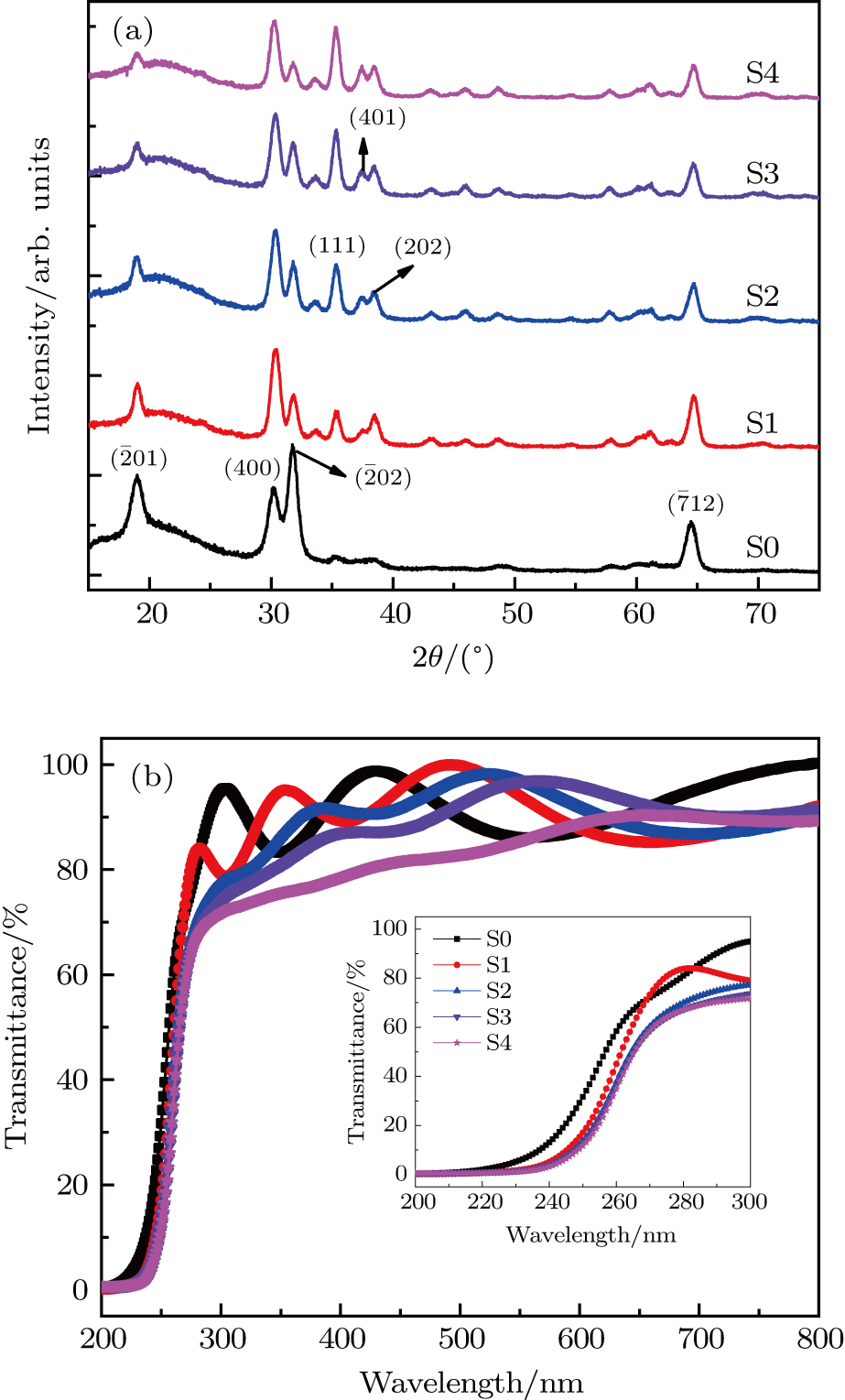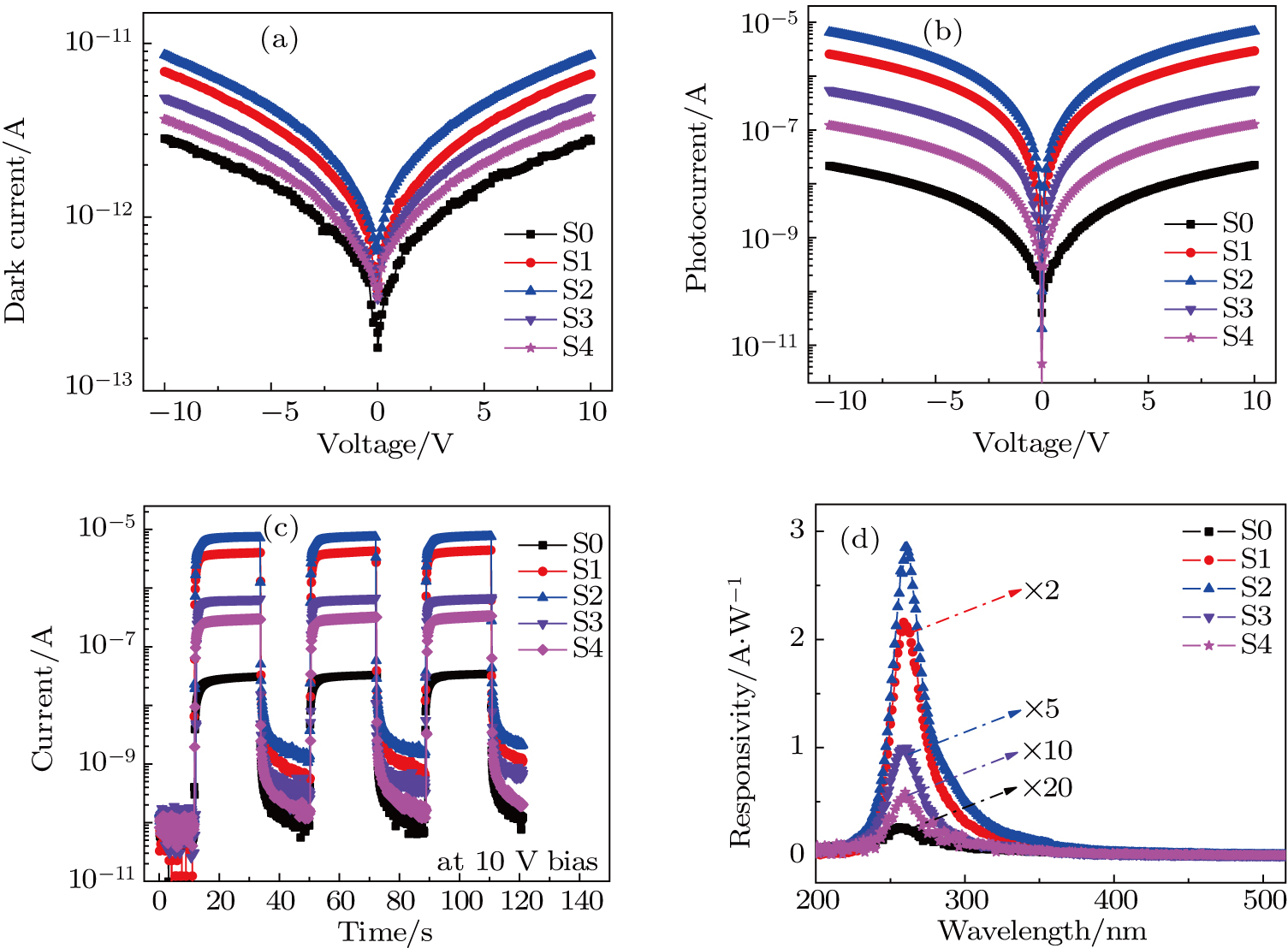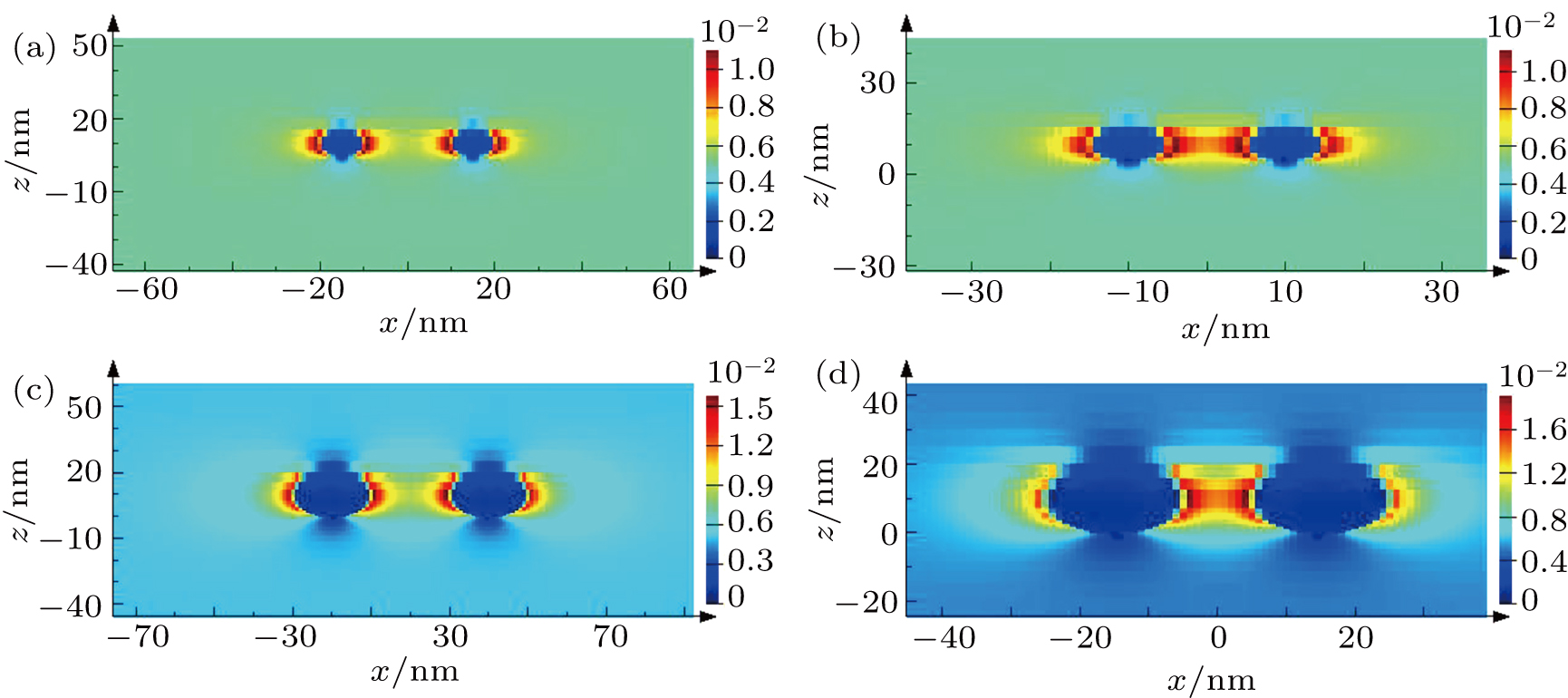Project supported by the National Natural Science Foundation of China (Grant Nos. 11674405 and 11675280) and the Fund from the Laboratory of Microfabrication in Institute of Physics, Chinese Academy of Sciences.
Project supported by the National Natural Science Foundation of China (Grant Nos. 11674405 and 11675280) and the Fund from the Laboratory of Microfabrication in Institute of Physics, Chinese Academy of Sciences.
† Corresponding author. E-mail:
Project supported by the National Natural Science Foundation of China (Grant Nos. 11674405 and 11675280) and the Fund from the Laboratory of Microfabrication in Institute of Physics, Chinese Academy of Sciences.
In the present work, we explore the solar-blind ultraviolet (UV) photodetectors (PDs) with enhanced photoresponse, fabricated on Ga/Ga2O3 nanocomposite films. Through pre-burying metal Ga layers and thermally post-annealing the laminated Ga2O3/Ga/Ga2O3 structures, Ga/Ga2O3 nanocomposite films incorporated with Ga nanospheres are obtained. For the prototype PD, it is found that the photocurrent and photoresponsivity will first increase and then decrease monotonically with the thickness of the pre-buried Ga layer increasing. Each of all PDs shows a spectrum response peak at 260 nm, demonstrating the ability to detect solar-blind UV light. Adjustable photoresponse enhancement factors are achieved by means of the surface plasmon in the nanocomposite films. The PD with a 20 nm thick Ga interlayer exhibits the best solar-blind UV photoresponse characteristics with an extremely low dark current of 8.52 pA at 10-V bias, a very high light-to-dark ratio of ∼ 8 × 105, a large photoresponsivity of 2.85 A/W at 15-V bias, and a maximum enhancement factor of ∼ 220. Our research provides a simple and practical route to high performance solar-blind UV PDs and potential applications in the field of optoelectronics.
The term solar-blind ultraviolet (UV) is due to the radiation in this region (220 nm∼280 nm) being almost completely absorbed by the ozone layer and thus the background radiation in the atmosphere is close to zero. The black background makes the solar-blind UV photodetector (PD) have low noise and high sensitivity simultaneously. Owing to the huge application prospects in civil and military areas, such as flame monitoring, space communication, biological medicine, and missile guidance, solar-blind UV PDs have been attracting extensive attention.[1,2] The high photon energy of solar-blind UV light enables the wide band gap semiconductors to serve as detection materials, including diamond,[3,4] AlGaN,[5,6] MgZnO,[7–9] Ga2O3, etc.[10–17] Compared with other wide band gap materials, Ga2O3 has a direct band gap (∼4.9 eV) and a high absorption coefficient (> 105 cm−1 near band edge) in the solar-blind UV spectral region, which avoids the complex band gap engineering problem and makes Ga2O3 a particularly suitable candidate for solar-blind UV photodetection.[18,19] To date, bulk,[11,12] thin-film,[13–15] and nanostructure[16,17] Ga2O3 solar-blind UV PDs have been proposed. The bulk and nanostructured Ga2O3 PDs usually exhibit superior sensitivity and photoresponsivity to the solar-blind UV light in contrast to their thin-film counterpart.[11–17] However, the complex synthesis technologies and high cost of the bulk Ga2O3 crystals and the low repeatability of Ga2O3 nanostructures greatly restrict their practical applications. Therefore, thin-film-type PDs are still the main research focus. On the other hand, the reported thin-film-type PDs, which have good photoresponse performances (> 1 A/W), are based on high-quality Ga2O3 single crystalline films.[14,15] The growth methods for these high-quality thin-films include molecular beam epitaxy, metal-organic chemical vapor deposition, and pulsed laser deposition, in which usually there are the needs of high-vacuum instruments, high growth temperatures, and complicated processes.[14,15,20] The expensive costs and rigorous conditions required by these synthesis techniques significantly restrict the industrial development of large-area films. Obviously, the current Ga2O3 PDs are far away from the industrialization demands, and it is urgently needed to explore a cost-effective and practical method to acquire a unique Ga2O3 material with improved solar-blind photoresponse performance.
Surface plasmon (SP) resonance is the phenomenon of collective electron oscillations on the surfaces of metal nanoparticles driven by incident light.[21,22] Under resonance state, the local electromagnetic field around the metal nanoparticles can be greatly enhanced,[23] and the scattering cross section of incident light increases at the same time, which greatly improve the interaction between the light and the material.[24] This principle ensures the SP effect, which is widely used in the fields of optoelectronics, such as detectors,[25–28] solar cells,[24] photocatalysts,[29] and Raman detection.[30] It is well established that the resonance peak of gallium (Ga) based plasmonic platform is adjustable from the visible to solar-blind UV spectral range.[31–33] Recently, we have achieved a Ga/Ga2O3 nanocomposite film through post-annealing the Ga2O3/Ga/Ga2O3 laminated film, and the corresponding solar-blind PD has remarkably enhanced responsivity due to the SP coupling effect, which will be published elsewhere.[34] It should be noted that the thickness of the Ga interlayer plays an important role in the photoresponse properties of Ga/Ga2O3 nanocomposite PDs, and the dependence of the PD performance on this key parameter has to be explored in detail.
Here in this work, we present a series of Ga/Ga2O3 nanocomposite solar-blind PDs with adjustable photoresponse enhancement factors caused by the SP coupling effect. The Ga/Ga2O3 nanocomposite films are obtained by annealing the Ga2O3/Ga/Ga2O3 triple-layer films in a tube furnace. By changing the thickness of the pre-buried Ga interlayer, the enhancement factor of the responsivity can be increased by about 4.5–220 times. The detector achieves the best solar-blind UV photoresponse performance when the interlayer Ga is 20-nm thick. The low dark current of 8.52 pA at 10-V bias along with the high peak responsivity of 2.85 A/W at 15-V bias indicates that the SP coupled PD is likely to have prospects of practical applications.
The Ga/Ga2O3 nanocomposite films were synthesized by post-annealing the laminated Ga2O3/Ga/Ga2O3 samples. Firstly, 100-nm Ga2O3 film was sputtered on a quartz substrate (500-μm thick) in pure argon (Ar) atmosphere at room temperature for about 10 min with a radio frequency of 60 W. Secondly, a metal Ga thin layer was grown on this Ga2O3 film through the thermal evaporation process. Finally, another 100-nm Ga2O3 layer was deposited on the top of the Ga interlayer. The laminated film samples are subsequently annealed at 1050 ○C for 30 min. The annealing process was carried out in a GSL-1400X vacuum high-temperature tube furnace. The whole heating and cooling process was implemented in an Ar atmosphere at a flow rate of 200 standard cubic centimeters per minute (sccm), and the pressure was kept at 1 atm (1 atm = 1.01325 × 105 Pa). The temperature ramping rates were set to be 10 ○C/min. After annealing, the Ga interlayer migrated upwards and formed discrete metal Ga nanospheres (NSs) embedded in the Ga2O3 matrix, which have been verified through the transmission electron microscopy (TEM) characterizations in our previous work.[34] Four Ga/Ga2O3 nanocomposite samples were prepared by annealing the laminated Ga2O3/Ga/Ga2O3 samples with different Ga layer thickness, denoted as S1 (10-nm Ga), S2 (20-nm Ga), S3 (30-nm Ga), and S4 (40-nm Ga), respectively. A sample with a thickness the same as that of Ga2O3 film and no Ga interlayer annealed under the same conditions was adopted as a control sample, denoted as S0.
The solar-blind UV PDs were fabricated by conventional UV photolithography and lift-off processes. The Sn-doped indium oxide (ITO, 100 nm) layer was sputtered at room temperature to form the Schottky contacts with the Ga2O3 films. A planar metal-semiconductor-metal (MSM) structure was adopted, with 5 μm in width spaced by a 5-μm gap, 300 μm in length, and 75 pair fingers in total.
An atomic force microscope (AFM, Brucker MultiMode 8) was employed to characterize the surface morphology of all the samples. The crystallinity of each of the annealed samples was confirmed by an x-ray diffractor (XRD, Rigaku SmartLab). Transmittance spectra of all samples were measured on a UV-3600 Plus (Shimadzu Corporation) UV-VIS-NIS spectrophotometer.
Due to the ultra-low dark current of the PD, the source-measurement unit in the Keithley 4200 semiconductor characterization system was used to obtain the current–voltage (I–V) curve in the dark. In other photoelectric measurements, the Keithley 6487 Picoammeter was used as a power supply. A hand-held lamp with 254-nm UV irradiation was used as a light source for the I–V curve under illumination and the time-dependent photoresponse. Evaluation of the photoresponse properties of PDs in a range of 200 nm to 600 nm was carried out by using an Omni-λ 180i grating spectrometer.
For a better illustration of the SP effect on the enhanced solar-blind UV detection capability, the spatial electric field distribution around the Ga NSs and the inter-sphere interaction between two Ga NSs are simulated with the finite-difference time-domain (FDTD) method.
Figures
To further investigate the crystal structures of all the samples, XRD measurements are carried out. Figure 




 | Fig. 2. (color online) (a) XRD patterns and (b) optical transmittance spectra of samples S0–S4. Inset shows the magnified curves around the absorption edges. |
Transmittance spectra of all the samples are exhibited in Fig.
Prototype solar-blind PDs are fabricated on these samples each with an MSM structure, and their photoresponse performance is shown in Fig.
| Table 1. Summary of the photoelectric properties of PDs. . |
To further explore the SP performance of the Ga NS array in the surrounding Ga2O3 matrix, the spatial electric field intensity distribution is simulated by the FDTD method. In order to match the results of S2, the diameters of the Ga NSs in the simulation are 10 nm and 20 nm, and the gaps between two NSs are 10 nm and 20 nm. Figures
A series of Ga NSs/Ga2O3 nanocomposite films is acquired through post-annealing the Ga2O3/Ga/Ga2O3 triple-layer films. The nanocomposite films are each composed of polycrystalline β-Ga2O3 matrix and discrete metal Ga NSs embedded therein. The sizes of the metal Ga NSs in the nanocomposite films vary when changing the metal Ga layer thickness. The corresponding PDs demonstrate adjustable solar-blind UV photoresponse enhancement factors due to the coupling efficiency varying by tuning the morphology of Ga NSs. The maximum peak responsivity reaches 2.85 A/W at 260 nm, two orders of magnitude higher than the maximum peak responsivity of the bare Ga2O3 PD. This work reveals the remarkable and tunable plasmonic coupling capability in Ga/Ga2O3 systems. The results presented here are of profound significance for studying plasmonics and detecting solar-blind UV light. Meanwhile, the simple, repeatable, and cost-effective method of fabricating the high-response Ga2O3 solar-blind UV PDs promises to have practical applications.
| [1] | |
| [2] | |
| [3] | |
| [4] | |
| [5] | |
| [6] | |
| [7] | |
| [8] | |
| [9] | |
| [10] | |
| [11] | |
| [12] | |
| [13] | |
| [14] | |
| [15] | |
| [16] | |
| [17] | |
| [18] | |
| [19] | |
| [20] | |
| [21] | |
| [22] | |
| [23] | |
| [24] | |
| [25] | |
| [26] | |
| [27] | |
| [28] | |
| [29] | |
| [30] | |
| [31] | |
| [32] | |
| [33] | |
| [34] | |
| [35] | |
| [36] | |
| [37] | |
| [38] | |
| [39] | |
| [40] | |
| [41] | |
| [42] | |
| [43] |




